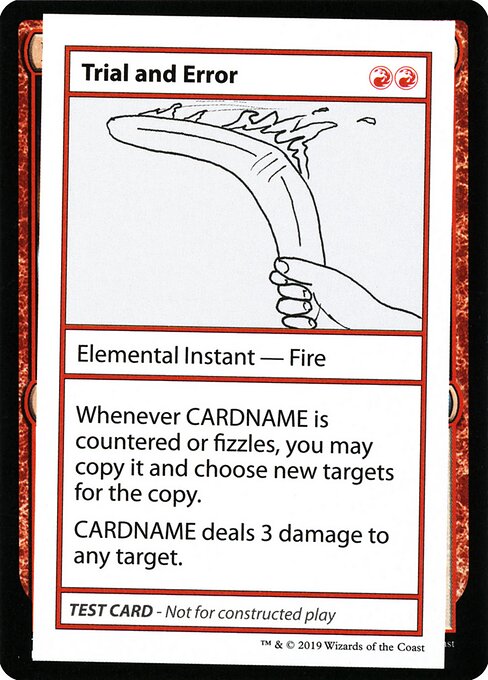
Image courtesy of Scryfall.com
Trial by Cost: How Rarity Mirrors Mana Cost in MTG
Rarity threads through Magic: The Gathering like a compass, guiding what players can expect to find in a draft or deck-building session—and sometimes signaling what a card can do on the battlefield. The card in focus here, Trial and Error, is a vivid case study in the delicate dance between mana cost and rarity. With a two-mana red investment—{R}{R}—this Elemental Instant from Mystery Booster Playtest Cards 2021 makes a bold statement: power isn’t locked behind a sky-high price tag, but rather perched on a ridge of risk, timing, and a dash of luck. 🧙♂️🔥
Two mana for an instant that deals 3 damage to any target is already the kind of pace red players crave. But Trial and Error isn’t content with a one-and-done burn—its real kicker is the flavor of opportunity baked into its rarity. Marked as rare, this card comes from a set that wore its playtest-on-a-different-planet vibe on its sleeve (cmb2: Mystery Booster Playtest Cards 2021). The rarity signals that this spell is not a throwaway common; it’s a deliberate design with a twist that elevates it above the usual two-mana burn spell. The relation between rarity and mana cost here is not a simple “more mana equals more power.” It’s a nuanced bet: a compact cost paired with a potent, situational upside that rewards clever timing and deck-building nuance. ⚔️
Whenever Trial and Error is countered or fizzles, you may copy it and choose new targets for the copy. Trial and Error deals 3 damage to any target.
That oracle text is the heart of why rarity and cost align so intriguingly. The immediate payoff is familiar—3 damage to any target is a respectable burn, a staple of red’s tempo. The kicker, though, is the copy-on-counter/ fizzled moment. You don’t simply lose your spell to a negate; you get a second chance to point the damage at a different target, or to pressure your opponent’s board with a second burn spell. It’s a paradox built into a rare card: you pay a modest mana cost for a guaranteed direct impact, then you unlock a contingency that rewards you for casting into a crowded or counter-happy format. That push-pull between guaranteed effect and conditional upside is precisely the kind of design flourish rarities often shepherd: a little extra complexity that rewards thoughtful play. 🧠🎲
Why a two-mana red spell can feel rare
In many eras of Magic, red’s bread-and-butter is efficiency and speed: cheap spells that punch fast, a harsh trade for late-game inevitabilities. Trial and Error fits that thesis on the surface, but its rarity hints at a more cautious design intention. A rare card with a low mana cost that enables an additional copy if countered invites deck-builders to weave it into longer, more interactive games. It rewards plans that anticipate disruption—counterspells, removal, and fizzles—turning a momentary setback into a potential swing. The rarity becomes a signal: this isn’t just a one-shot burn; it’s a controlled risk with a possible payoff that scales with how the game unfolds. 💎
Rarity as signal, not guarantee
Rarity should be read as a guide, not a prophecy. Trial and Error demonstrates that a rare card can sit at a lower mana threshold yet still offer a high ceiling through tactical play. Some two-mana red spells crater in the face of mass removal, while others, like this one, lean into counterplay and positional advantage. When you see rare, you’re invited to explore its potential synergies—copying effects, targeting multiple threats, or creating pressure on a stalled board. This card’s specific mechanic—the ability to copy itself if it’s countered or fizzles—embeds a subtle risk management layer: you’re filtering for favorable moments to cast, banking on a turn where your flex is more valuable than a straightforward burn. The end result is a neat demonstration of how rarity communicates not just raw power, but texture and resilience in play. ⚡🧩
Design notes: flavor, art, and playtest history
The art, courtesy of Chris Clay, captures a spark of reckless experimentation—the literal essence of a Trial and Error moment. The card’s placement in a “playtest” subset underscores its experimental flavor: a rare that dares to test the edge of red’s impulsive identity. The Mystery Booster line is famous for surprising shifts in power level and quirky mechanics; Trial and Error fits that spirit by pairing conventional burn with an unconventional preservation of value when disruption happens. For collectors, this is a reminder that rarity isn’t merely a price tag; it’s an invitation to explore a design space where a card’s cost and its risk-reward profile weave into the story you tell at the table. 🎨🧙♂️
Whether you’re drafting, collecting, or teaching new players the basics of how mana curves shape outcomes, this card is a compact lesson in MTG economics: a modest mana investment can unlock an unexpectedly resilient payoff, especially when your opponent’s answers create the opportunity to clone your own spell. And if you’re balancing your game-night setup with the right desk gear, a reliable, stylish mouse pad makes the table feel just a little more legendary—hence the gentle nudge to our product below. 🔥🎯
While rarity and mana cost are just pieces of a broader puzzle, Trial and Error remains a crisp reminder of how MTG designers thread power, scarcity, and player agency into every line of text. The next time you draft a red deck with a penchant for clever misdirection, you’ll be thinking not just about what you can cast, but what you can redeem if your counterplay backfires in your favor. ⚔️💎
Custom Mouse Pad — Round or Rectangle Neoprene Non-Slip Desk PadMore from our network
- https://crypto-acolytes.xyz/blog/post/phot_g_mean_mag-reveals-a-distant-hot-stars-quiet-visibility/
- https://transparent-paper.shop/blog/post/unlocking-product-improvement-with-predictive-analytics/
- https://crypto-acolytes.xyz/blog/post/why-indie-developers-are-innovating-faster-than-ever/
- https://transparent-paper.shop/blog/post/parallax-unlocks-distance-to-distant-hot-blue-star/
- https://blog.digital-vault.xyz/blog/post/elevate-journal-design-with-vintage-digital-paper/